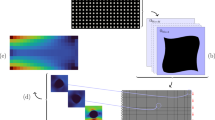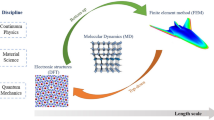Abstract
The DMO (discrete material optimization) technique is employed in structural synthesis dealing with the selection of a material belonging to a group of candidate materials. It has mainly been employed in the optimization for orientation of layers of composite laminates. The DMO is based on an interpolation in the form of a weighted sum of candidate materials. The weights are nonlinear functions of penalized design variables that are solved by continuous optimization, leading to proper material selection. The preferred way of solution has been by sequential approximate optimization (SAO), based on Taylor series approximations (TSA) as surrogate functions of the structural responses. However, due to the complexity of the DMO formulation the classical local surrogate techniques become of questionable efficiency in adequately capturing structural response behavior. To improve the quality of the surrogate models, it is here proposed the use of the weighting functions to form intermediate design variables in terms of which a higher quality TSA is created. Improvements in the convergence characteristics of the SAO is observed, opening new perspectives to the efficient application of the DMO concept.







Similar content being viewed by others
References
Assan AA (2003) Método dos elementos finitos: primeiros passos, 2nd edn. Unicamp, Campinas
Barthelemy JFM, Haftka RT (1993) Approximation concepts for optimum structural design - a review. Struct Optim 5:129–144
Bendsøe MP, Sigmund O (2004) Topology optimization - theory, methods and applications, 2nd edn. Springer, Berlin
Bruyneel M (2011) SFP - a new parameterization based on shape functions for optimal material selection: application to conventional composite plies. Struct Multidiscip Optim 43:17–27
Bruyneel M, Deltour D, Duysinx P, Gao T, Scoonjans T, Fleury C (2010) New developments in material parametrization for optimal fiber orientations in composite structures. In: Proceedings of the 2nd Internation Conference on Engineering Optimization, September 6–9, Lisbon, Portugal
Bruyneel M, Duysinx P, Fleury C, Gao T (2011) Extension of the shape functions with penalization for composite ply orientation. AIAA J 49:2325–2329
Ferreira RTL (2013) Contributions in the optimization of laminated composites. PhD thesis. Instituto Tecnológico de Aeronáutica, São José dos Campos/SP
Ferreira RTL, Rodrigues HC, Guedes JM, Hernandes JA (2014) Hierarchical optimization of laminated fiber reinforced composites. Compos Struct 107:246–259
Fleury C, Braibant V (1986) Structural optimization: a new dual method using mixed variables. Int J Numer Methods Eng 23:409–428
Gao T, Zhang W, Duysinx P (2012) A bi-value coding parameterization scheme for the discrete optimal orientation design of the composite laminate. Int J Numer Methods Eng 91:98–114
Haftka RT, Kamat MP (1985) Elements of Structural Optimization. Martinus Nijhoff, The Hague
Jones RM (1999) Mechanics of composite materials, 2nd edn. Taylor and Francis, Philadelphia
Lund E (2009) Buckling topology optimization of laminated multi-material composite shell structures. Compos Struct 91:158–157
Lund E, Stegmann J (2005) On structural optimization of composite shell structures using a discrete constitutive parametrization. Wind Energy 8:109–124
Lund E, Stegmann J (2006) Eigenfrequency and buckling optimization of laminated composite shell structures using discrete material optimization. In: IUTAM Symposium on Topological Design Optimization of Structures, Machines and Materials: Status and Perspectives. Springer
Lund E, Johansen LS, Hvejsel CG, Olesen EL (2008) Multi-criteria multi-material topology optimization of laminated composite structures. In: Proceedings of the 12th AIAA/ISSMO Multidisciplinary Analysis and Optimization Conference. Victoria, Britsh Columbia
Lust RV, Schmit LA (1986) Alternative approximation concepts for space frame synthesis. AIAA J 24:1676–1684
Mills-Curran WC, Lust RV, Schmit LA (1983) Approximation methods for space frame synthesis. AIAA J 21:1571–1580
Niu B, Olhoff N, Lund E, Cheng G (2010) Discrete material optimization of vibrating laminated composite plates for minimum sound radiation. Int J Solids Struct 47:2097–2114
Rao SS (2009) Engineering optimization: theory and practice, 4th edn. John Wiley, Hoboken
Reddy JN (1996) An introduction to the finite element method, 2nd edn. McGraw-Hill, New York
Reddy JN (1997) Mechanics of laminated composite plates: theory and analysis. CRC Press, Boca Raton
Rozvany GIN (2009) A critical review of established methods of structural topology optimization. Struct Multidiscip Optim 37:217–237
Salajegheg E, Vanderplaats GN (1986/1987) An efficient approximation method for structural synthesis with reference to space structures. Space Struct J 2:165–175
Schmit LA, Farshi B (1973) Some approximation concepts for structural synthesis. In: Proceedings of the 14th AIAA/ASME/SAE Structures, Structural Dynamics and Materials Conference, Williamsburg, Virginia
Schmit LA (1976) Approximation concepts for efficient structural synthesis. NASA, Contractor Report CR 2552
Sigmund O, Torquato S (1997) Design of materials with extreme thermal expansion using a three-phase topology optimization method. J Mech Phys Solids 45:1037–1067
Sigmund O, Torquato S (1999) Design of smart composite materials using topology optimization. Smart Mater Struct 8:365–379
Starnes JH, Haftka RT (1979) Preliminary design of composite wings for buckling, stress and displacement constraints. J Aircr 16:564–570
Stegmann J (2004) Analysis and optimization of laminated composite structures. PhD thesis. Aalborg University, Aalborg
Stegmann J, Lund E (2005) Discrete material optimization of general composite shell structures. Int J Numer Methods Eng 62:2009–2027
Svanberg K (1987) Method of moving asymptotes - a new method for structural optimization. Int J Numer Methods Eng 24:359–373
Thomas HL, Vanderplaats GN (1993) The state of the art of approximation concepts in structural optimization. In: Rozvany G I N (ed) Optimization of Large Structural Systems, vol 1, Kluwer, pp 257–270
Vanderplaats GN, Salajegheg E (1988) An efficient approximation technique for frequency constraints in frame optimization. Int J Numer Methods Eng 26(5):1057–1069
Vanderplaats GN, Salajegheg E (1989) A new approximation method for stress constraints in structural synthesis. AIAA J 27:352–358
Yoshida N, Vanderplaats GN (1988) Structural optimization using beam elements. AIAA J 26:454–462
Acknowledgements
We are thankful to the financial support of the project CAPES/FCT 243/2011 and also to Vanderplaats Research and Development, Inc. (www.vrand.com) by the gentle cession of a DOT v5.7 research license.
Author information
Authors and Affiliations
Corresponding author
Appendix A: Common material weighting functions
Appendix A: Common material weighting functions
The DMO uses material interpolations like in (1). Popular and efficient weighting functions w i (x) are the so-called DMO4, DMO5 ( Stegmann 2004; Stegmann and Lund 2005) and the SFP ( Bruyneel 2011).
1.1 A.1 DMO4
The DMO4 scheme uses the following weights w i (x) to define the material interpolation (1):
In the (22) above, the weights w i are functions of the x i design variables, bounded in such a way that 0≤x i ≤1. This way, the w i are also bounded between 0 and 1. The parameter p is a penalization power which aims to penalize intermediate combinations of materials, by reducing its relative stiffness when p>1, as found in the well-known SIMP (Solid Isotropic Material with Penalization) ( Bendsøe and Sigmund 2004). The number n of candidates can be any.
This material weighting works specially well in problems of compliance minimization ( Stegmann 2004) but the weights w i do not necessarily add up to unity for intermediate values of x i . This cause ill-characterized material physical representation during intermediate optimization stages, where the weights possibly present intermediate values between 0 and 1. This is critical when interpolating mass properties in general (Lund and Stegmann 2006: Niu et al. 2010 and optimizing for buckling loads ( Lund 2009). Trying to deal with this issue, the DMO5 formulation was developed.
1.2 A.2 DMO5
The DMO5 weighting is basically a normalization of the DMO4:
It always ensures \({\sum }_{i=1}^{n}w_{i}=1\), which provides a much better material representation during intermediate iterations of an optimization process. However, it is reported that this normalization adds some difficulties in the optimization convergence, facilitating the appearance of intermediate values of the w i in the final optimized solutions ( Stegmann 2004). The reason for this behavior seems to be the more complicated functions w i (x) now used, and because the weights’ normalization also affect the intermediate materials penalization ( Niu et al. 2010).
1.3 A.3 SFP
In Bruyneel et al. (2010) and Bruyneel (2011) it was proposed a new DMO-like scheme called SFP (shape function with penalization), which consists in interpolating materials in (1) using functions commonly employed in the FE method. Its most common form uses the bi-linear interpolation functions of a four-node quadrilateral element to select materials among four candidates.
These functions are defined in terms of the variables x 1,x 2, that could be seen as elemental natural coordinates, and now bounded to permit −1≤x i ≤1 ( Reddy 1996). In (24), the penalty p has the same functionality as in SIMP and DMO4/5. However, the use of p≠1 does not renders the characteristic of weights adding up to unity. When four materials are interpolated the SFP reduces in a half the number of design variables needed in comparison to the DMOs, since it uses x 1,x 2 when the DMOs would use x 1,...,x 4. However, it is clear that the set of weights shown in (24) does not permit working with any number of candidates in (1). Nevertheless, in composite laminates practical applications, it is common the problem of distributing laminae at 0∘/±45∘/90∘ orientations, and SFP is clearly effective for that. Variations and extensions of this weighting can be found in Bruyneel et al. (2011) and Gao et al. (2012), but (24) is the form of interest here.
Rights and permissions
About this article
Cite this article
Ferreira, R.T.L., Hernandes, J.A. Advanced approximations for sequential optimization with discrete material interpolations. Struct Multidisc Optim 51, 1305–1320 (2015). https://doi.org/10.1007/s00158-014-1216-6
Received:
Revised:
Accepted:
Published:
Issue Date:
DOI: https://doi.org/10.1007/s00158-014-1216-6




